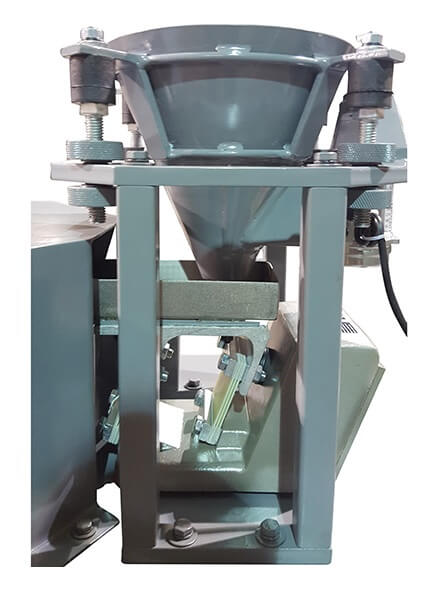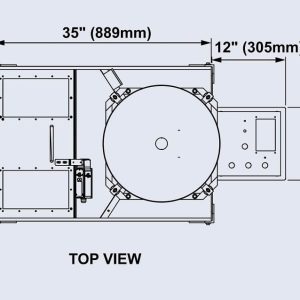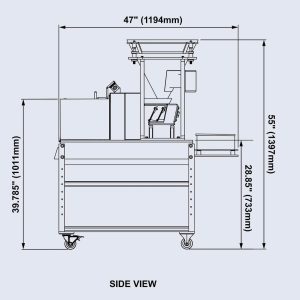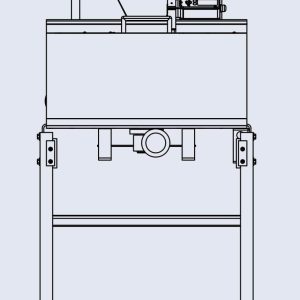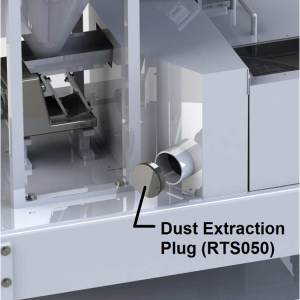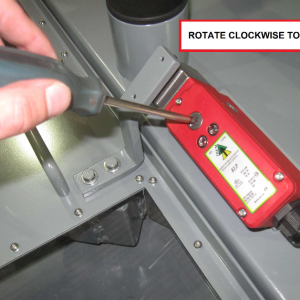SAMPLE SPLITTER OVERVIEW
This bench-type rotary sample splitter is supplied with two variable speed drives. The rotary table has a motor that will rotate from 0 to 53 revolutions per minute. The vibratory feeder motor will give you 0 to 11 feet per minute. Upon the gravity flow and vibrator agitation from the feeding hopper, you will be able to achieve the desired splitting ratio by adjusting speeds of the vibratory feeder and the rotating table. See setup instructions on the following pages for details.
The collection containers supplied with these units are based on customer request at the time of ordering. There are many container divisions that are compatible with each machine. Feel free to contact the factory about different container divisions available for your machine.
SAMPLE SPLITTER SETUP INSTRUCTIONS
Before you can begin splitting, it is important that the machine is properly setup for the material you plan on processing. Every material has unique properties so it is recommended to run several test samples using different settings to determine the optimal configuration for your material. Use the steps below as a guide to set up your machine.
1.) Hopper adjustment:
For very fine materials it is typical to have the hopper set closer to the tray. For coarse materials the hopper should be set high enough for the biggest particles to easily pass under the lower edge of the hopper.
The hopper can be adjusted up and down to change the opening height at the bottom. To do so, loosen the knurled knobs in the corners around the hopper. Adjust the hopper up or down as necessary and re tighten all 4 knobs.
2.) Rotary Carousel Adjustment:
Turn the carousel on and use the dial on the control panel to adjust the carousel rotating speed minimizing dust and particles flying out as material falls into the containers. Use good judgment to establish a suitable speed as you observe the way material falls.
3.) Vibrator Feeder Adjustment:
Before turning on the vibrator feeder, fill the hopper with test material. To prevent dust and overflow when loading the hopper with very fine material, pour a small amount in first to fill the opening at the bottom before pouring in the entire sample.
With the carousel rotating, turn the vibrator feeder on. You should begin to see material moving from beneath the hopper on to the tray. The vibrator feeder also has a variable speed control to adjust the speed at which material flows. Turn the dial to a point where you are satisfied with the rate of flow. You may want to re adjust the hopper height at this stage if material is flowing too fast, too slow or clogging.
4.) Hopper Vibrator: (optional)
Some machines are supplied with a vibrator on the hopper to prevent clogging at the output and sticking of material to the inside. This is not adjustable, simply turn it on or off and take note of the effect it has on the way material flows. Not all material requires that the hopper vibrator be turned on.
OPERATING INSTRUCTIONS OF THIS ROTARY SAMPLE SPLITTER
In order to safely achieve accurate and repeatable results, it is critical that you follow the operating procedure below. Refer to the setup instructions on page 3 before you begin running samples.
- Place all of the collection containers on the carousel tray and ensure that they are seated properly within the carousel edge. For machines supplied with reject collection capability, make sure the containers are properly hooked on the rotating carousel in the center.
- Pour material into the hopper.
- Turn on the hopper vibrator (optional) if needed.
- Turn on the carousel motor and adjust to the desired speed.
- Adjust the vibrator feeder to the desired speed before turning it on.
- Close the lid and turn on the vibrator feeder.
- Let the machine run until all material has been collected within the containers.
Note: It is imperative that the carousel motor dial, vibrator feeder dial, and hopper vibrator switch are not touched while splitting occurs, as this will cause inaccurate results.










